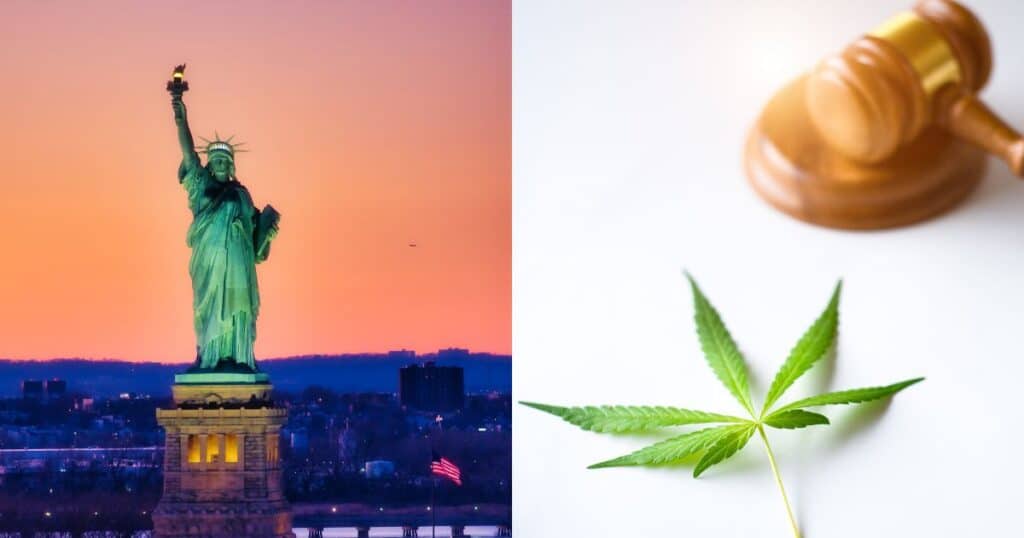The cannabis industry in New York has been one of the most closely-watched markets in the United States, hailed as an opportunity to implement a fair, equitable, and thriving cannabis economy. However, recent developments suggest a more complicated path forward as regulators, businesses, and advocates grapple with systemic challenges. From recommendations on license caps to ongoing legal struggles, the state’s legal cannabis market is in flux.
New York’s Cannabis Licensing System
New York legalized recreational cannabis in 2021 with the Marijuana Regulation & Taxation Act (MRTA), leading to the creation of the Office of Cannabis Management (OCM) and the Cannabis Control Board (CCB). Central to the rollout was fostering social equity, ensuring that individuals disproportionately impacted by cannabis criminalization would benefit from the new market.
However, New York’s cannabis licensing process has encountered slow rollouts, unprocessed applications, and once again another, a legal setback.
The CAB’s Recommendation to Cap Retail Licenses
The New York Cannabis Advisory Board (CAB) recently advised the Cannabis Control Board (CCB) to limit retail marijuana licenses to 1,600 for now (excluding microbusinesses), based on data suggesting the market could eventually support up to 2,000 dispensaries.
This recommendation stems from concerns about:
- Market Saturation: Opening too many dispensaries simultaneously could lead to compressed revenues for current operators.
- Proximity Protections: Guidelines to prevent retailers from clustering too closely need review before increasing license counts.
- Illicit Market Competition: Despite efforts, illegal dispensaries still overshadow the regulated market, necessitating strategic rollout plans to stabilize legal operations.
While 261 dispensaries currently operate in New York, thousands of applications remain unprocessed. CAB hopes the recommendation will ensure gradual growth, giving license holders a better chance at success.
Current Licensing Bottlenecks
While CAB’s recommended cap is significant, it’s far from the only issue stalling New York’s cannabis licensing efforts. The state faces critical challenges in issuing licenses, including a recent lawsuit.
Licensing Delays and Overdue Applications
The state’s Office of Cannabis Management has only processed about 100 licenses each month, leaving many waiting over a year for approval. The December application round alone received over 3,000 applications—most untouched. It’s estimated that fewer than 300 applications awaiting review fall into the priority category where applicants secured physical retail locations upfront.
Thousands of applicants continue to pay rent on properties they secured for licensing purposes, further straining resources. These delays mitigate the full promise of what the state envisioned when passing MRTA, forcing businesses and entrepreneurs to endure financial losses.
Legal Challenges Disrupting Licensing
Adding to the turbulence, New York’s cannabis program has hit another legal snag. A state Supreme Court judge has issued an injunction that temporarily halts the processing of Conditional Adult Use Retail Dispensary (CAURD) applications, impacting at least 340 applicants, reports the Business of Cannabis.
The lawsuit centers on the claim that OCM overstepped its authority by allowing early CAURD applicants to bypass key requirements, such as having secured retail locations. The court ruled in favor of the plaintiffs, arguing that these waivers potentially violate MRTA.
This roadblock delays not just CAURD licenses but also provisional licenses submitted later, further clogging an already overburdened system. Applicants and investors are left unsure of when regular business might resume.
Regulation Enforcement and Market Realities
While license issuance struggles persist, enforcement remains an uphill battle. OCM and CCB face challenges stabilizing the legal market amidst rampant competition from illegal dispensaries.
Enforcement Efforts
Since spring 2024, OCM has conducted over 1,200 inspections, padlocked 400 illegal dispensaries, and confiscated up to 17,000 pounds of illicit cannabis. It has also issued $15 million in fines. Despite these measures, illegal operations continue to overshadow licensed businesses, undercutting revenues and stifling market growth.
Declining Dispensary Revenue
Although New York’s marijuana retail sales are expected to surpass $1 billion by the end of 2024, average monthly revenue per dispensary is weaker than anticipated. With 60% of dispensaries now earning under $1 million annually—a far cry from sustainability—many operators face financial uncertainty.
What’s Next for New York’s Cannabis Market?
While these challenges may seem daunting, they are not insurmountable. Here’s what lies ahead for New York’s cannabis market.
Temporary License Caps vs. License-Freezing
The CAB’s recommendation for a license limit aims to prevent market saturation. Still, questions remain about how license limits might interact with the recent court-ordered freeze on several license categories. Stakeholders will need to find a balance between fiscal responsibility, market demand, and the urgency of including social equity applicants.
Comprehensive Market Data Analysis
OCM leaders have committed to conducting deeper analysis on market capacity, revenue metrics, and license impact, with recommendations expected in early 2025. A well-researched plan could stabilize licensing rollouts and enable more informed decision-making.
New York’s cannabis market is undoubtedly at a crossroads. The potential for this industry is enormous, but only if regulators, operators, and the community work together toward sustainable solutions.
To fix the current bottlenecks, here are several steps stakeholders might prioritize:
Accelerate Licensing Without Overloading: OCM and CCB should process licenses at a faster yet sustainable rate to avoid market saturation while clearing backlogs effectively.
Leverage Proximity Data: Decisions on retail licenses should integrate proximity and economic data to map equitable retail distribution.
Boost Illegal Market Crackdowns: Expanding enforcement efforts to target illicit sellers will strengthen the legitimacy of licensed dispensaries.
Reduce Burden on Applicants: Delays in licensing have hurt many applicants required to pay expensive rents or loans. Creating contingency guidelines around delays can prevent these business losses.
The ongoing legal delays and licensing bottlenecks aren’t just procedural inconveniences—they’re hurdles for countless entrepreneurs aspiring to participate in New York’s cannabis industry, the vast majority of whom are social equity applicants. While OCM and CCB evaluate new data and implement structural reforms, businesses must stay informed and ready to adapt.

















